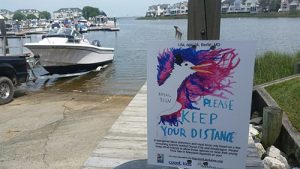
OCEAN CITY — With another summer season quickly approaching, conservation advocates this week are reminding recreational boaters the sandy islands in the coastal bays that serve as temporary homes to endangered species of beach-nesting birds remain off limits to human interaction.
Two years ago, the federal Army Corps of Engineers dredged the navigation channels in and around the coastal bays behind Ocean City and used the roughly 400,000 cubic yards of sand to restore some long-forgotten islands in the bays that hadn’t appeared on charts since the 1930s, including a four-acre spit now known as Tern Island.
That summer, Tern Island quickly became a hub for recreational boating as weekend enthusiasts waded ashore with beach chairs, umbrellas and coolers. At one point, recreational boaters unofficially claimed the island as their own, wading ashore with an American flag, a flag pole and bags of concrete in a spontaneous act of patriotism.
However, the sandy islands in coastal bays were never intended for human interaction, instead created as temporary homes for several species of endangered nesting birds who return each year to lay their eggs along the sandy strips. In advance of the summer season last year, the Maryland Department of Natural Resources (DNR) and its conservation-minded partners including the Maryland Coastal Bays Program (MCBP), for example, launched a public outreach program warning recreational boaters the sandy islands in the coastal bays were off limits including an extensive sign campaign. Roughly 100 signs designed by local students were erected around marinas and boat ramps around the resort area warning boaters to give a wide berth to the ecologically sensitive areas.
The campaign apparently worked last year with few incidents or interactions with boats and humans reported in the nesting areas. However, with a new summer season approaching and the new flock of recreational boaters who might not be aware of the restrictions on the islands in the coastal bays, the public outreach program has been renewed.
The DNR along with local conservation organizations such as the MCBP and the Audubon Maryland-DC are again asking boaters and paddlers to give the endangered birds like black skimmers, common terns and royal terns a break from the bustle of human activity and stay off the islands were they nest.
It is also important to note it is illegal to land a boat or step foot on an island posted with the signs to protect nesting birds and the Maryland Natural Resources Police, the enforcement arm of the DNR, patrol the coastal bays and will warn offenders although pricey citations are a measure of last resort. The islands are off limits from April 1 to September 15.
Beach-nesting colonial birds are far more sensitive to disturbance from humans and other factors than most birds because they lay their eggs directly on the bare ground where they are highly vulnerable to predators like foxes, gulls and crows. The eggs can also actually bake in the sun if the parent birds are chased away from the nesting areas for only a few minutes. In addition, another threat is swamping caused by boat wakes when vessels pass to closely to the shorelines of the islands.
Since 1992, the state’s black skimmer population has declined from 278 nesting pairs to just six pairs confined to a tiny island fragment were their nests are at risk. Similarly, common terns have declined 86 percent since the early 1990s and royal terns by 60 percent. For that reason, Audubon Maryland-DC Director Dave Curson said this week the importance of keeping the islands in the coastal bays off limits to boaters is even more acute.
“The Maryland coastal bays are the only place in the state where these birds breed,” he said. “This is one reason why Audubon has identified the coastal bays as an Important Bird Area, an essential site for bird species that are vulnerable.”
In the past 25 years, more than 300 acres of islands eroded away or were developed in the bays behind Ocean City and Assateague. The original 29 breeding islands have now been reduced to just four. With those four, including the popular Tern Island, now hosting colonial nesting birds like terns and skimmers, the importance of leaving them alone needs to be re-emphasized with a new summer boating season in full swing.
“Respecting island closures on small sand islands in the coastal bays is the most significant individual action that recreational boaters can take to help conserve Maryland’s remaining black skimmers, common terns and royal terns,” said DNR Regional Ecologist David Brinker.
The MCBP has been at the forefront of the effort to protect the islands and has worked closely with the local business community and even the Ocean City public works department on getting the signs posted. The outreach effort worked last year, but with a new season and a new crop of boaters, the message needs to be reinforced.
“It is very gratifying to see folks supporting the restrictions on these important bird islands,” said MCBP Science Coordinator Roman Jesien.

